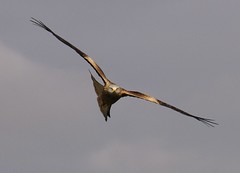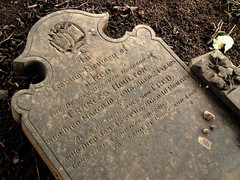
Click on the photo to enlarge it and you will see a darling Wren's nest. They quite often nest in our stables, but this one has taken advantage of a number of spare haynets hanging from a hook in the barn - a fairly cat-proof spot too. The base of the nest appears to be strands of hay, then wonderfully embellished with moss. Just think how soft and warm that will be for the Wren babies. I shall try and keep you posted as to how many, in due course.
We have lots of birdlife here. Above the window in this room, Bluetits are nesting. They have wriggled in between the window frame and the stone wall and have it cosy there. Higher up, beneath the eaves, we have House Sparrows, who congregate in little brown-and-grey gangs in the arches of the rambling rose, Paul's Himalayan Musk, and cheep annoyingly all day long. At the back of the rose arbour we did have a Blackbird's nest, but part of the trellis has come down so they may have to look for another nest-site this year. One year we had Redstarts (such beautiful birds) nesting in bushes along by the stream, but they were young birds, and foolish, and had their nest too low and one of our cats took a young fledgling. We often have Swallows nesting in the Cart Shed, swooping in and out of the doorway or the little window at the top. I think it may well have been the original 18th C bakery for our house, as there is another small window at the back, and these would not have been necessary just for a cart shed. In the summer, we often see a Spotted Flycatcher come and perch on the branch of a dead tree over the stables. I can watch him (or her) as I am washing up. Blue Tits also nest in a hole in the cart shed wall, where the mortar has fallen out. Safe as houses in there.
Redstart:

We did have Rooks setting up home at the top of the Elm trees along the border of our land in the Yard, but Next Door said they were his trees and allowed the guys who run the Shoot to shoot the bottoms out of the nests, so the Rooks went elsewhere. They insisted that the Rooks would take the young pheasant poults, but according to my bird books, Rooks don't do that - unlike other members of the Crow family, which have nasty habits. Magpies are particularly nasty, taking fledglings when they can, and we have a number of those who nest locally and regularly check out what's on offer in our garden.
Visiting our nut nets in the winter we have Blue Tits, Great Tits, Coal Tits, Nuthatches, Greater Spotted Woodpeckers, Sparrows, and no end of little Chaffinches picking up the bits beneath. We have more Jackdaws than we could shake a stick at - the wretches swoop down and frighten Amber (the outside stray cat) away from her food, and then they eat it instead. They are very aware of what goes on here and perch on the power cables, calling up their friends the moment anything edible appears. They nest in the farm buildings opposite. They have a hierarchy - the oldest greyest Granny Jackdaw is the boss, and is very canny. At the first sight of anyone with a gun, she and her troop have skedaddled! They also deliberately punish any young bird who has overstepped the mark. I don't know how a youngster infringes these Jackdaw Rules & Regs, but boy, does he know when he has. I have seen them many a time chasing and harrying a bird through the ash trees beyond the yard, setting up a tremendous scolding as they chase him from branch to branch, pecking him when they can get close enough. This happened right outside my front door recently, with a bird being pinned down and viciously attacked, and SUCH a clamour they were making. I had to go out and break it up, but they carried on with the hue and cry in the farmyard. My mum, growing up, had a pet Jackdaw which her father had found injured. They had an aviary in the yard, and popped "Jackie" in it, and he became very tame. They eventually taught him to talk, or at least, say his name.
We have our Robins of course - there is one who will come and perch on the kitchen window ledge when he is hungry and give me a hard-done-by look so I put out some crumbs for him. He is quite often in the stable, picking up any crumbs which are spilt from feed bowls. He will help me garden too, and pass comment on my digging techniques!

I often hear the woodpeckers drumming in early spring, in the hollow trees down the hill. We only rarely see a Green Woodpecker, but regularly see the Spotted ones about the place.
Buzzard:

We have Buzzards a-plenty, soaring high above the house, or perched on nearby trees. They nest in the woodland on the almost verticle hillside below us, and swoop low across the road as you ride past. I like to see them in the early morning light, hunting for worms as the sun warms the slope of the little field on the hillside. It is hard to imagine such a regal bird "worming" but when I drive down to Whitemill, there is a field there with Rich Pickings, and I once counted over 2 dozen Buzzards, well spread out, hunting for worms, and keeping company with the Herons, whose Heronry is in the dense oak woodland on Merlin's Hill. On frosty mornings they are perched along the hedgerow, waiting for the ground to thaw sufficiently. One winter morning this year, I even saw a Little Egret by the side of the River Towy. I was driving, unfortunately, so couldn't look too long and hard, but there was no mistaking it.

It is the Red Kites I love best, with their forked tails and rufous rump, and their splendid wings which arch and flare, unlike the little short stubby Buzzard wings. I could watch them for hours as they glide on the thermals. We see them regularly - they nest further up the valley. They were almost extinct once, killed by over-zealous Gamekeepers, but have now been reintroduced into England too, and are thriving. I always get a thrill when I see one and can understand why Sea Eagles were buried with the dead at Isbister, the 'Tomb of the Eagles' up in Orkney. They must have been the 'totem' bird of that Neolithic clan.


We have our share of the Wagtails too - "Polly Dishwashers" as my mum used to call them - I don't think it's purely a Hampshire name for them though, as it's used in the West Country as well. We have the little black and white Pied Wagtails, often seen along the top of the farmyard walls, looking for insects, or on the ridges of the barns opposite, keeping company with the beautiful Water Wagtails (Grey Wagtails) which have sulphur yellow rumps. When I was little, I used to look at the illustrations in my little Observer's Book of Birds, and think they had got the captions wrong, as the Grey Wagtail had lots of yellow and the Yellow Wagtail had lots of grey! Sometimes when I am working in my sewing room in the attic, I open the Velux window in the roof and, standing on a chair, look out at the countryside, and watch the Water Wagtails stuttering along the roof tiles. They are so elegant.

Sometimes I see chains of Long-Tailed Tits in our hedgerows, and once there was a nest of theirs in a dense part of the hedge by the stream. They are such pretty little birds. So are the Goldfinches, which come and feed on the Teasels by the paddock each autumn and must nest somewhere locally too.
Down by the river we see Herons daily, unless the river is in spate, and often see the whirring flight of the little Dipper as he flees downstream. They nest under the bridge, and I love to stand on the bridge and watch them bobbing up and down on a rock mid-stream. They remind me of Dartmoor, and the fast-flowing streams and rivers there, and are still magical to me, who grew up amongst the chalk streams and rivers of the Itchen and Test. Once in a blue moon, we see the Kingfisher - a flash of turquoise and he is gone. I've only seen 4 or 5 in my entire life.
Meanwhile, I bird-spot when I can. No great rarities (apart from the Egret) but much pleasure all the same.



















































